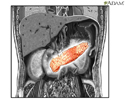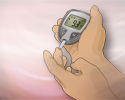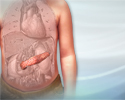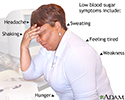Home blood sugar testing
Diabetes - home glucose testing; Diabetes - home blood sugar testingDiabetes - home glucose testing; Diabetes - home blood sugar testing
The Basics
Tests for home blood sugar testing
A Closer Look
- Diabetes - type 2 - InDepth (Detailed Report)
- Diabetes - type 1 - InDepth (Detailed Report)
- Stroke (Alternative Medicine)
- Stroke - InDepth (Detailed Report)
- Heart failure - InDepth (Detailed Report)
- Viral hepatitis (Alternative Medicine)
- Pneumonia - InDepth (Detailed Report)
- Exercise - InDepth (Detailed Report)
- Attention deficit hyperactivity disorder (Alternative Medicine)
- Psoriasis-In-Depth (Detailed Report)
Homeostasis - Animation
Homeostasis
Animation
Type 2 diabetes - Animation
Type 2 diabetes
Animation
Type 1 diabetes - Animation
Type 1 diabetes
Animation
Seizures - Animation
Seizures
Animation
Low blood sugar symptoms
Symptoms such as weakness, feeling tired, shaking, sweating, headache, hunger, nervousness and irritability are signs that a person's blood sugar is getting dangerously low. A person showing any of these symptoms should check their blood sugar. If the level is low (70 mg/dL), a sugar-containing food should be eaten right away.
Low blood sugar symptoms
illustration
Fetal blood testing
Fetal blood testing is performed during labor to test the blood pH of the baby which can determine its well-being during delivery. A small puncture is made in the scalp and fetal blood droplets are collected in a thin glass tube. Testing the scalp pH can help your doctor decide if your fetus is getting enough oxygen during labor. This helps determine if your baby is healthy enough to continue labor, or if a forceps delivery or cesarean delivery might be the best route of birth.
Fetal blood testing
illustration
Newborn screening testing
Blood is routinely drawn from newborn infants for testing. Blood is obtained by a heel stick and collected on a special blotter paper. Routine testing usually includes phenylketonuria, thyroid function, hemoglobin S (sickle cell disease), and may test for other disorders. Newborn screening programs vary from state to state. Testing can be tailored to the local population, determining what routine testing should be done.
Newborn screening testing
illustration
Homeostasis - Animation
Homeostasis
Animation
Type 2 diabetes - Animation
Type 2 diabetes
Animation
Type 1 diabetes - Animation
Type 1 diabetes
Animation
Seizures - Animation
Seizures
Animation
Low blood sugar symptoms
Symptoms such as weakness, feeling tired, shaking, sweating, headache, hunger, nervousness and irritability are signs that a person's blood sugar is getting dangerously low. A person showing any of these symptoms should check their blood sugar. If the level is low (70 mg/dL), a sugar-containing food should be eaten right away.
Low blood sugar symptoms
illustration
Fetal blood testing
Fetal blood testing is performed during labor to test the blood pH of the baby which can determine its well-being during delivery. A small puncture is made in the scalp and fetal blood droplets are collected in a thin glass tube. Testing the scalp pH can help your doctor decide if your fetus is getting enough oxygen during labor. This helps determine if your baby is healthy enough to continue labor, or if a forceps delivery or cesarean delivery might be the best route of birth.
Fetal blood testing
illustration
Newborn screening testing
Blood is routinely drawn from newborn infants for testing. Blood is obtained by a heel stick and collected on a special blotter paper. Routine testing usually includes phenylketonuria, thyroid function, hemoglobin S (sickle cell disease), and may test for other disorders. Newborn screening programs vary from state to state. Testing can be tailored to the local population, determining what routine testing should be done.
Newborn screening testing
illustration
Home blood sugar testing
Diabetes - home glucose testing; Diabetes - home blood sugar testingDiabetes - home glucose testing; Diabetes - home blood sugar testing
The Basics
Tests for home blood sugar testing
A Closer Look
- Diabetes - type 2 - InDepth (Detailed Report)
- Diabetes - type 1 - InDepth (Detailed Report)
- Stroke (Alternative Medicine)
- Stroke - InDepth (Detailed Report)
- Heart failure - InDepth (Detailed Report)
- Viral hepatitis (Alternative Medicine)
- Pneumonia - InDepth (Detailed Report)
- Exercise - InDepth (Detailed Report)
- Attention deficit hyperactivity disorder (Alternative Medicine)
- Psoriasis-In-Depth (Detailed Report)
Home blood sugar testing
Diabetes - home glucose testing; Diabetes - home blood sugar testingDiabetes - home glucose testing; Diabetes - home blood sugar testing
The Basics
Tests for home blood sugar testing
A Closer Look
- Diabetes - type 2 - InDepth (Detailed Report)
- Diabetes - type 1 - InDepth (Detailed Report)
- Stroke (Alternative Medicine)
- Stroke - InDepth (Detailed Report)
- Heart failure - InDepth (Detailed Report)
- Viral hepatitis (Alternative Medicine)
- Pneumonia - InDepth (Detailed Report)
- Exercise - InDepth (Detailed Report)
- Attention deficit hyperactivity disorder (Alternative Medicine)
- Psoriasis-In-Depth (Detailed Report)
Review Date: 2/28/2024
Reviewed By: Sandeep K. Dhaliwal, MD, board-certified in Diabetes, Endocrinology, and Metabolism, Springfield, VA. Also reviewed by David C. Dugdale, MD, Medical Director, Brenda Conaway, Editorial Director, and the A.D.A.M. Editorial team.







